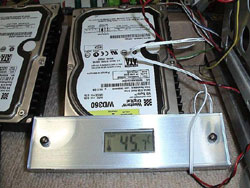|
|
|
|
|
Western Digital Raptor WD740GD |
|
Join the community - in the OCAU Forums!
|
Summary, Usage and Conclusions
PERFORMANCE SUMMARY
The interpretation of the results with the 3 tested drives is quite easy. Even a quick glance through the previous 6 tables with the test results reveals that the WD740 is consistently leading the pack. It is by a clear margin better than the older WD360 and it is outclassing the 7,200 rpm Maxtor in each and every test, be it as single disk or in RAID 0 with 2 disks.
The “Basic Performance” result table shows that the new WD740 indeed managed to improve the already excellent performance characteristics of the older WD360. Access time, burst speed and read/write transfer are all clearly improved. The important random disk access time stands now at 7.6 milliseconds which makes the Maxtor Diamond Plus 9 with 15.3 milliseconds look like a product from a distant past. The WD740 transfer rate is starting at around 73 MB/sec at the outer zones compared to the WD360's 59 MB/sec. Additionally the transfer rate is “decaying” much less towards the inner zones than the Diamond Plus 9. Both effects are resulting in an excellent average read time of 65.2 MB/sec for the single Raptor and almost 120 MB/sec in RAID 0. The massive gain shows that the WD740 is well suited for RAID 0, which is not the case for all hard disks. Maxtor’s D740X for example, their first ATA 133 unit, was a notoriously bad performer when RAIDed.
GENERAL USAGE
A rotational speed of 10,000 rpm is naturally producing more heat and vibration than 7,200 rpm. As already mentioned, both Raptors have a heatsink-like “rugged” case design and a heavier housing than 7,200 rpm disks to compensate for this. We measured a temperature of around 33C~35 C in idle and between 44C and 46C under load on the hottest spot of both the WD360 and the WD740. The idle temperature was almost identical with the Maxtor Diamond Plus, but under load temperature it was around 5 C higher. We recommend making sure that a Raptor has good contact with the PC case to ensure heat transfer, to use active cooling when using 2 Raptors RAID 0, and to have enough space for air circulation between them.

We did not experience the high-pitched noise some Raptor users are reporting. None of our initially tested four WD360 samples emitted such noise and the same goes for the two WD740 samples in this test round. The Raptor however sounds different from 7,200 disks when it is working. The mechanical noise when the heads are moving is clearly louder and sounds also harder, more mechanical. This is particularly noticeable when a heavily fragmented disk is de-fragmented, causing intense reading and writing to the disk. In such an extreme situation the Raptor sounds like a heavy machine gun firing in the distance. Both Raptor versions are by the way entirely identical when it comes to noise. All this makes us wonder whether Western Digital has indeed implemented a fluid bearing motor on the WD740.
Unfortunately we also found that the peculiar RAID 0 noise pattern already observed with the WD360 still exists with the WD740. A single Raptor disk is completely silent when idling. In RAID 0 however they are emitting, while idling, a constant low level noise pattern. It seems that the disk heads are permanently moving, probably recalibrating. We initially thought that maybe the ICH5-R (Max 3 Southbridge) from which we were running the Raptors was to blame. But changing the Raptors to the Max 3 on-board SiL3114 RAID controller and even trying another motherboard did not help. We therefore believe that this low level idle noise pattern in RAID 0 has something to do with the Raptor’s firmware or mechanical design.
CONCLUSION
Over the years we have tested many new hard disks. All of them could better the results of their predecessors. But we have never seen a new disk which is outclassing the competition by such a wide margin. Our results show that the Western Digital WD 740 Raptor has:- for an IDE/ATA disk, unprecedented low disk access time and high transfer rates
- amazingly fast performance when applications are running
- a clear speed advantage over even the previous WD360 Raptor
- strong suitability for RAID 0x2
The WD740 is widely available and has been since the beginning of 2004, for around 410 AUD in Australia, 200 Euro in Europe and 260 USD in the US. At the end we can only repeat the recommendation from our 2 previous Raptor test rounds: A “Must Have” for the enthusiast desktop user!
Check out the latest Gallery entries in the PC Database!
|
|
Advertisement:
All original content copyright James Rolfe.
All rights reserved. No reproduction allowed without written permission.
Interested in advertising on OCAU? Contact us for info.
|

|


